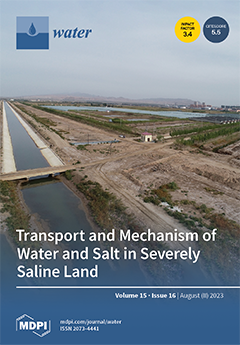Organic fertilizer applications and subsurface drainage are two important measures for improving coastal saline soil; however, nitrous oxide (N
2O) emissions from saline soil under a combination of these two measures are seldom evaluated. In this study, saline soil cultivated with sunflowers (
Helianthus annuus L.) was employed as an experimental system. Prior to the experiment, the saline soils were buried with three different spacings (10 m (S1), 15 m (S2), and 20 m (S3)) of subsurface drainage pipes. The nitrogen nutrients that are needed by sunflowers came from two different nitrogen sources (organic and inorganic fertilizer), including six application schemes of either 100% organic fertilizer (100%OF), 75% organic fertilizer combined with 25% inorganic fertilizer (75%OF), 50% organic fertilizer (50%OF), 25% organic fertilizer (25%OF), 0% organic fertilizer (0%OF), and no fertilizer (CK). The results show that the cumulative N
2O emissions from the treatments under S1, S2, and S3 throughout the entire growth period were 8.9–15.8, 9.5–17.5, and 10.1–17.6 kg ha
−1, respectively. A smaller spacing between adjacent drainage pipes or a higher replacement proportion of organic fertilizer reduced the accumulative N
2O emissions. The increased replacement of organic fertilizer decreased the soil salinity, whereas it increased the C/N ratio and total carbon content. The fertilization treatments significantly increased the nitrogen uptake of sunflower plants, with increase ranges of 18.1–47.2%, 8.6–40.5%, and 8.8–34.5% under S1, S2, and S3, respectively, compared with CK. The highest yield of sunflowers was achieved under S2 combined with 25%OF, reaching 3.82 t ha
−1. Correlation analysis showed that the N
2O emission flux was positively correlated with the soil salinity, crop yield, and crop nitrogen uptake, whereas it was negatively correlated with the total carbon, C/N ratio, and organic carbon content. We concluded that using 25% organic fertilizer instead of inorganic fertilizer was beneficial for reducing N
2O emissions while maintaining the crop yield under subsurface drainage.
Full article





